HI6006 Competitive Strategy: Strategy Development Tools Essay
VerifiedAdded on 2022/10/06
|8
|2146
|13
Essay
AI Summary
This essay provides a comprehensive analysis of three key strategic development tools: PESTLE analysis, SWOT analysis, and Porter's Five Forces. It begins with an introduction to strategic development and its importance in business, highlighting how these tools help businesses identify threats, challenges, strengths, and opportunities. The essay delves into PESTLE analysis, explaining how it helps businesses monitor macro-environmental factors, such as political, economic, social, technological, legal, and environmental factors, using the Australian retail industry as an example. It then explores SWOT analysis, examining internal strengths and weaknesses alongside external opportunities and threats, with examples from Qantas Airlines. Finally, the essay discusses Porter's Five Forces framework, detailing how it defines industry competition and profitability, using Telstra as an example. The conclusion emphasizes the value of these tools in formulating effective business strategies in response to market dynamics.
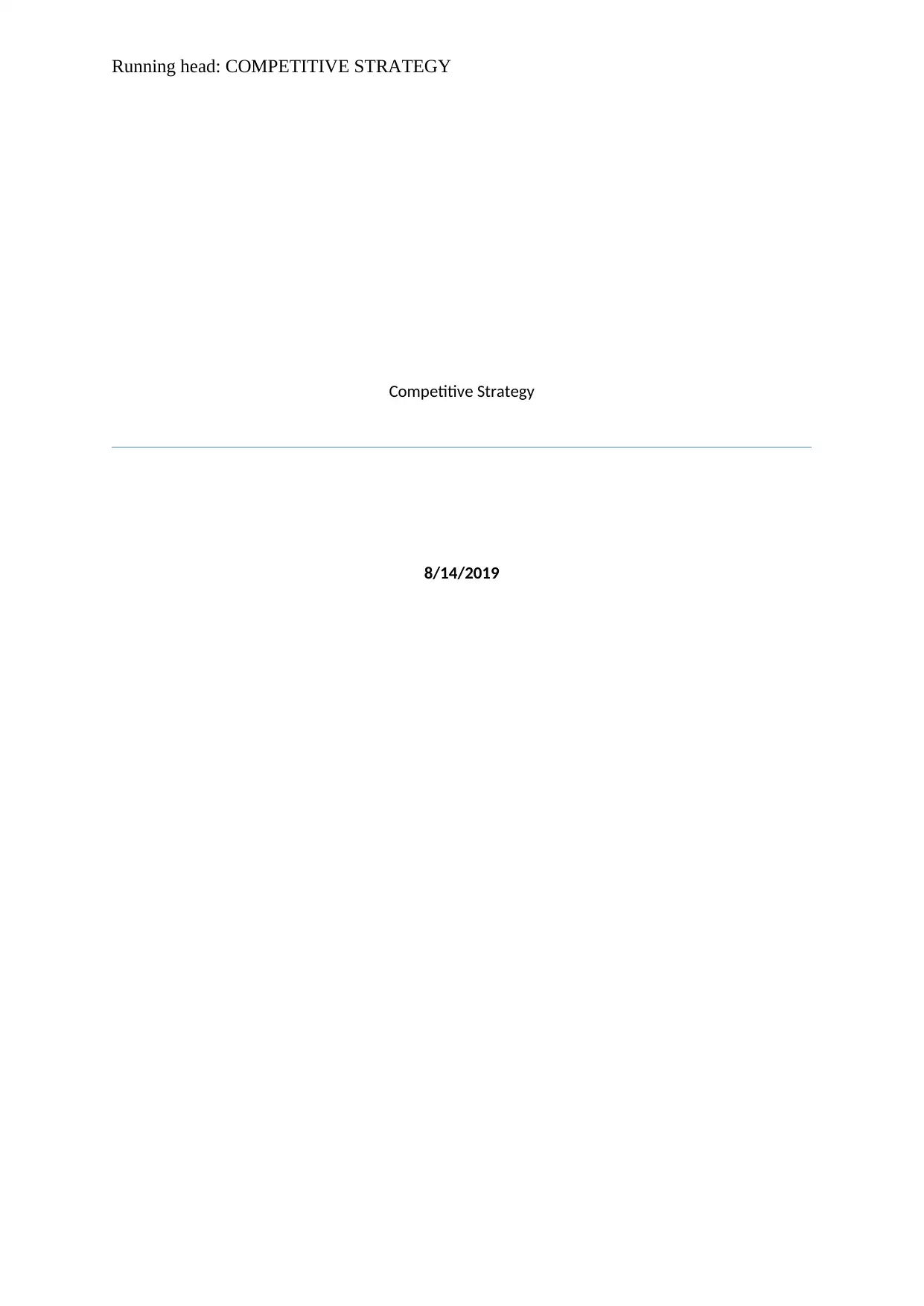
Running head: COMPETITIVE STRATEGY
Competitive Strategy
8/14/2019
Competitive Strategy
8/14/2019
Paraphrase This Document
Need a fresh take? Get an instant paraphrase of this document with our AI Paraphraser
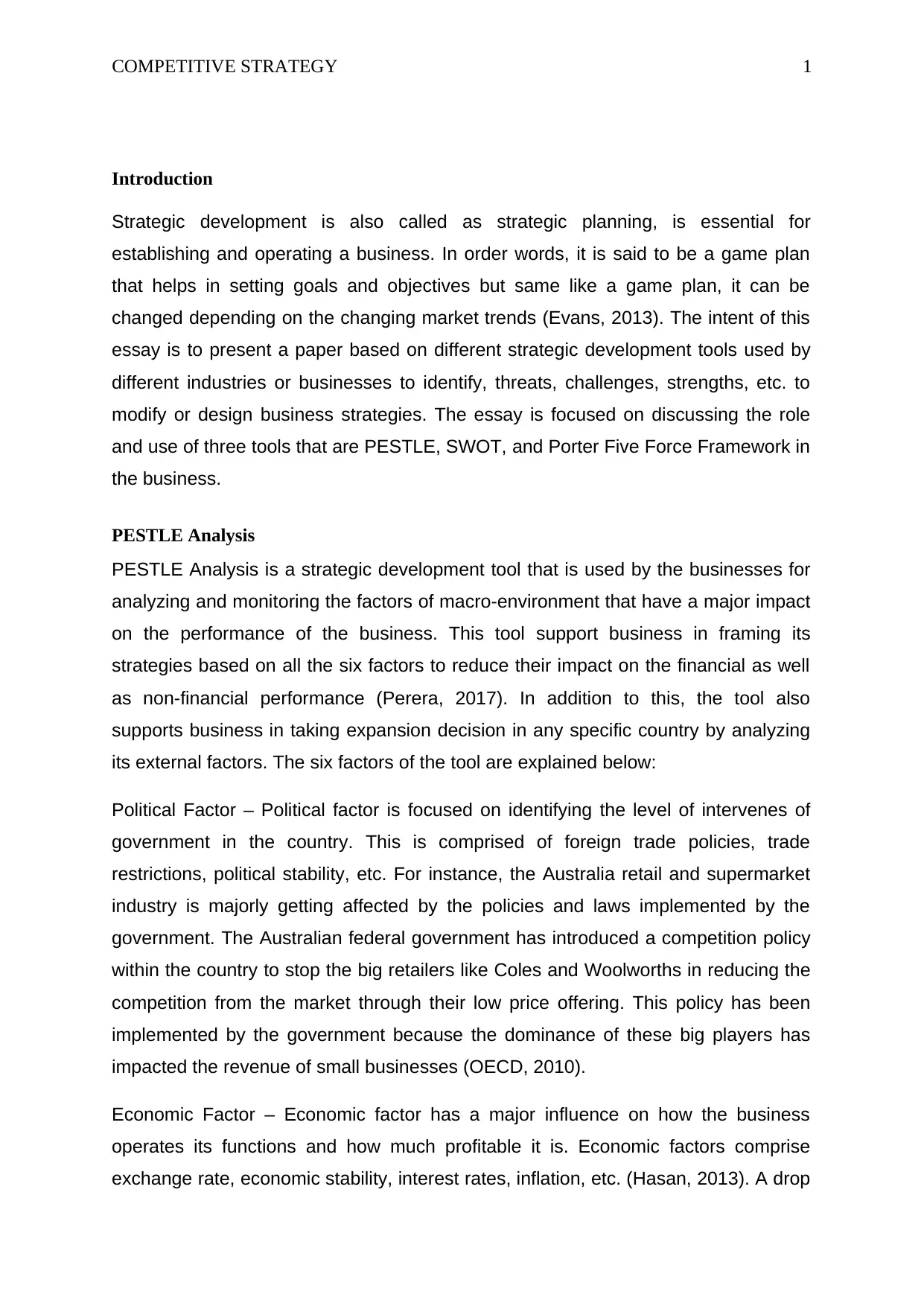
COMPETITIVE STRATEGY 1
Introduction
Strategic development is also called as strategic planning, is essential for
establishing and operating a business. In order words, it is said to be a game plan
that helps in setting goals and objectives but same like a game plan, it can be
changed depending on the changing market trends (Evans, 2013). The intent of this
essay is to present a paper based on different strategic development tools used by
different industries or businesses to identify, threats, challenges, strengths, etc. to
modify or design business strategies. The essay is focused on discussing the role
and use of three tools that are PESTLE, SWOT, and Porter Five Force Framework in
the business.
PESTLE Analysis
PESTLE Analysis is a strategic development tool that is used by the businesses for
analyzing and monitoring the factors of macro-environment that have a major impact
on the performance of the business. This tool support business in framing its
strategies based on all the six factors to reduce their impact on the financial as well
as non-financial performance (Perera, 2017). In addition to this, the tool also
supports business in taking expansion decision in any specific country by analyzing
its external factors. The six factors of the tool are explained below:
Political Factor – Political factor is focused on identifying the level of intervenes of
government in the country. This is comprised of foreign trade policies, trade
restrictions, political stability, etc. For instance, the Australia retail and supermarket
industry is majorly getting affected by the policies and laws implemented by the
government. The Australian federal government has introduced a competition policy
within the country to stop the big retailers like Coles and Woolworths in reducing the
competition from the market through their low price offering. This policy has been
implemented by the government because the dominance of these big players has
impacted the revenue of small businesses (OECD, 2010).
Economic Factor – Economic factor has a major influence on how the business
operates its functions and how much profitable it is. Economic factors comprise
exchange rate, economic stability, interest rates, inflation, etc. (Hasan, 2013). A drop
Introduction
Strategic development is also called as strategic planning, is essential for
establishing and operating a business. In order words, it is said to be a game plan
that helps in setting goals and objectives but same like a game plan, it can be
changed depending on the changing market trends (Evans, 2013). The intent of this
essay is to present a paper based on different strategic development tools used by
different industries or businesses to identify, threats, challenges, strengths, etc. to
modify or design business strategies. The essay is focused on discussing the role
and use of three tools that are PESTLE, SWOT, and Porter Five Force Framework in
the business.
PESTLE Analysis
PESTLE Analysis is a strategic development tool that is used by the businesses for
analyzing and monitoring the factors of macro-environment that have a major impact
on the performance of the business. This tool support business in framing its
strategies based on all the six factors to reduce their impact on the financial as well
as non-financial performance (Perera, 2017). In addition to this, the tool also
supports business in taking expansion decision in any specific country by analyzing
its external factors. The six factors of the tool are explained below:
Political Factor – Political factor is focused on identifying the level of intervenes of
government in the country. This is comprised of foreign trade policies, trade
restrictions, political stability, etc. For instance, the Australia retail and supermarket
industry is majorly getting affected by the policies and laws implemented by the
government. The Australian federal government has introduced a competition policy
within the country to stop the big retailers like Coles and Woolworths in reducing the
competition from the market through their low price offering. This policy has been
implemented by the government because the dominance of these big players has
impacted the revenue of small businesses (OECD, 2010).
Economic Factor – Economic factor has a major influence on how the business
operates its functions and how much profitable it is. Economic factors comprise
exchange rate, economic stability, interest rates, inflation, etc. (Hasan, 2013). A drop
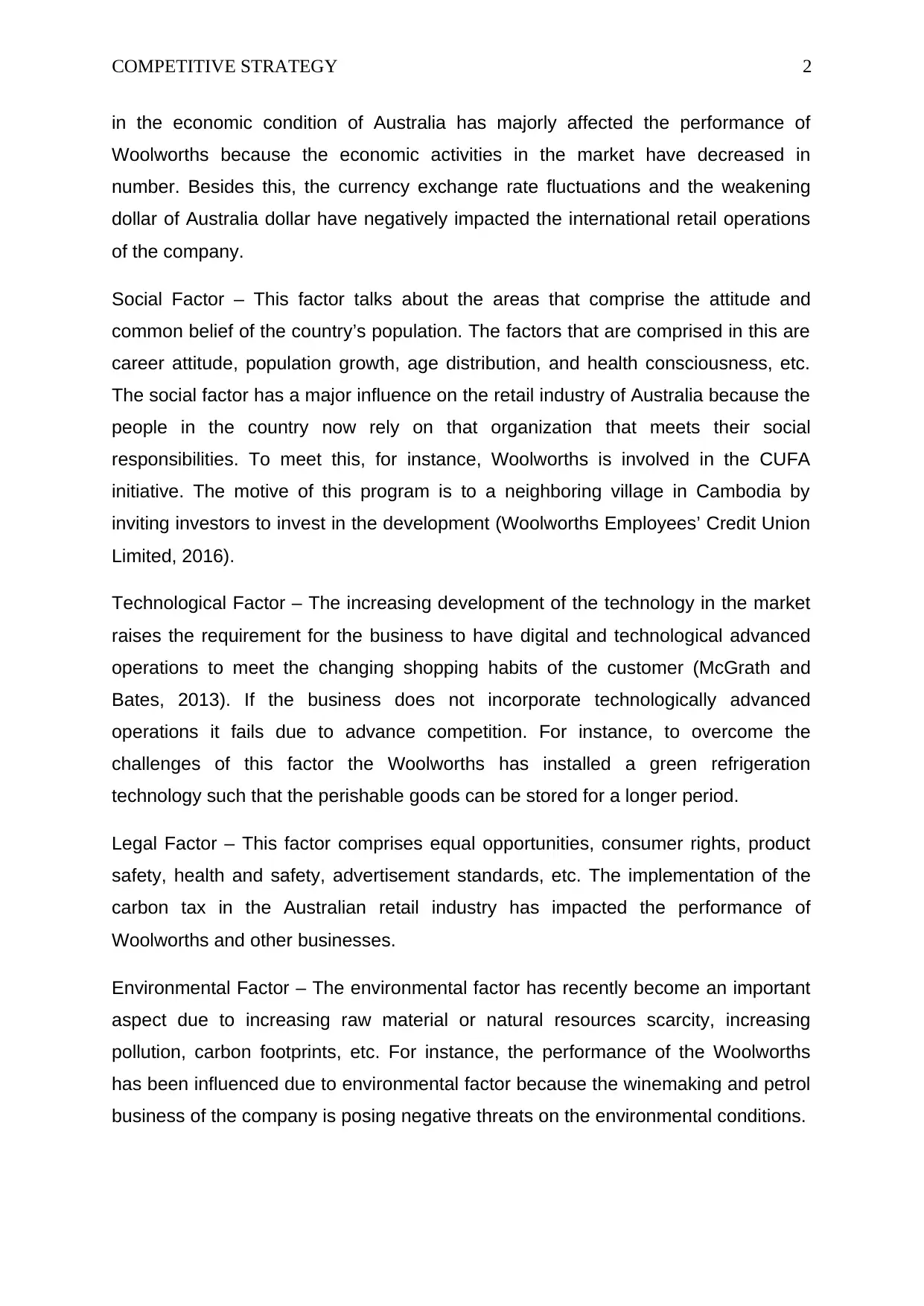
COMPETITIVE STRATEGY 2
in the economic condition of Australia has majorly affected the performance of
Woolworths because the economic activities in the market have decreased in
number. Besides this, the currency exchange rate fluctuations and the weakening
dollar of Australia dollar have negatively impacted the international retail operations
of the company.
Social Factor – This factor talks about the areas that comprise the attitude and
common belief of the country’s population. The factors that are comprised in this are
career attitude, population growth, age distribution, and health consciousness, etc.
The social factor has a major influence on the retail industry of Australia because the
people in the country now rely on that organization that meets their social
responsibilities. To meet this, for instance, Woolworths is involved in the CUFA
initiative. The motive of this program is to a neighboring village in Cambodia by
inviting investors to invest in the development (Woolworths Employees’ Credit Union
Limited, 2016).
Technological Factor – The increasing development of the technology in the market
raises the requirement for the business to have digital and technological advanced
operations to meet the changing shopping habits of the customer (McGrath and
Bates, 2013). If the business does not incorporate technologically advanced
operations it fails due to advance competition. For instance, to overcome the
challenges of this factor the Woolworths has installed a green refrigeration
technology such that the perishable goods can be stored for a longer period.
Legal Factor – This factor comprises equal opportunities, consumer rights, product
safety, health and safety, advertisement standards, etc. The implementation of the
carbon tax in the Australian retail industry has impacted the performance of
Woolworths and other businesses.
Environmental Factor – The environmental factor has recently become an important
aspect due to increasing raw material or natural resources scarcity, increasing
pollution, carbon footprints, etc. For instance, the performance of the Woolworths
has been influenced due to environmental factor because the winemaking and petrol
business of the company is posing negative threats on the environmental conditions.
in the economic condition of Australia has majorly affected the performance of
Woolworths because the economic activities in the market have decreased in
number. Besides this, the currency exchange rate fluctuations and the weakening
dollar of Australia dollar have negatively impacted the international retail operations
of the company.
Social Factor – This factor talks about the areas that comprise the attitude and
common belief of the country’s population. The factors that are comprised in this are
career attitude, population growth, age distribution, and health consciousness, etc.
The social factor has a major influence on the retail industry of Australia because the
people in the country now rely on that organization that meets their social
responsibilities. To meet this, for instance, Woolworths is involved in the CUFA
initiative. The motive of this program is to a neighboring village in Cambodia by
inviting investors to invest in the development (Woolworths Employees’ Credit Union
Limited, 2016).
Technological Factor – The increasing development of the technology in the market
raises the requirement for the business to have digital and technological advanced
operations to meet the changing shopping habits of the customer (McGrath and
Bates, 2013). If the business does not incorporate technologically advanced
operations it fails due to advance competition. For instance, to overcome the
challenges of this factor the Woolworths has installed a green refrigeration
technology such that the perishable goods can be stored for a longer period.
Legal Factor – This factor comprises equal opportunities, consumer rights, product
safety, health and safety, advertisement standards, etc. The implementation of the
carbon tax in the Australian retail industry has impacted the performance of
Woolworths and other businesses.
Environmental Factor – The environmental factor has recently become an important
aspect due to increasing raw material or natural resources scarcity, increasing
pollution, carbon footprints, etc. For instance, the performance of the Woolworths
has been influenced due to environmental factor because the winemaking and petrol
business of the company is posing negative threats on the environmental conditions.
⊘ This is a preview!⊘
Do you want full access?
Subscribe today to unlock all pages.

Trusted by 1+ million students worldwide
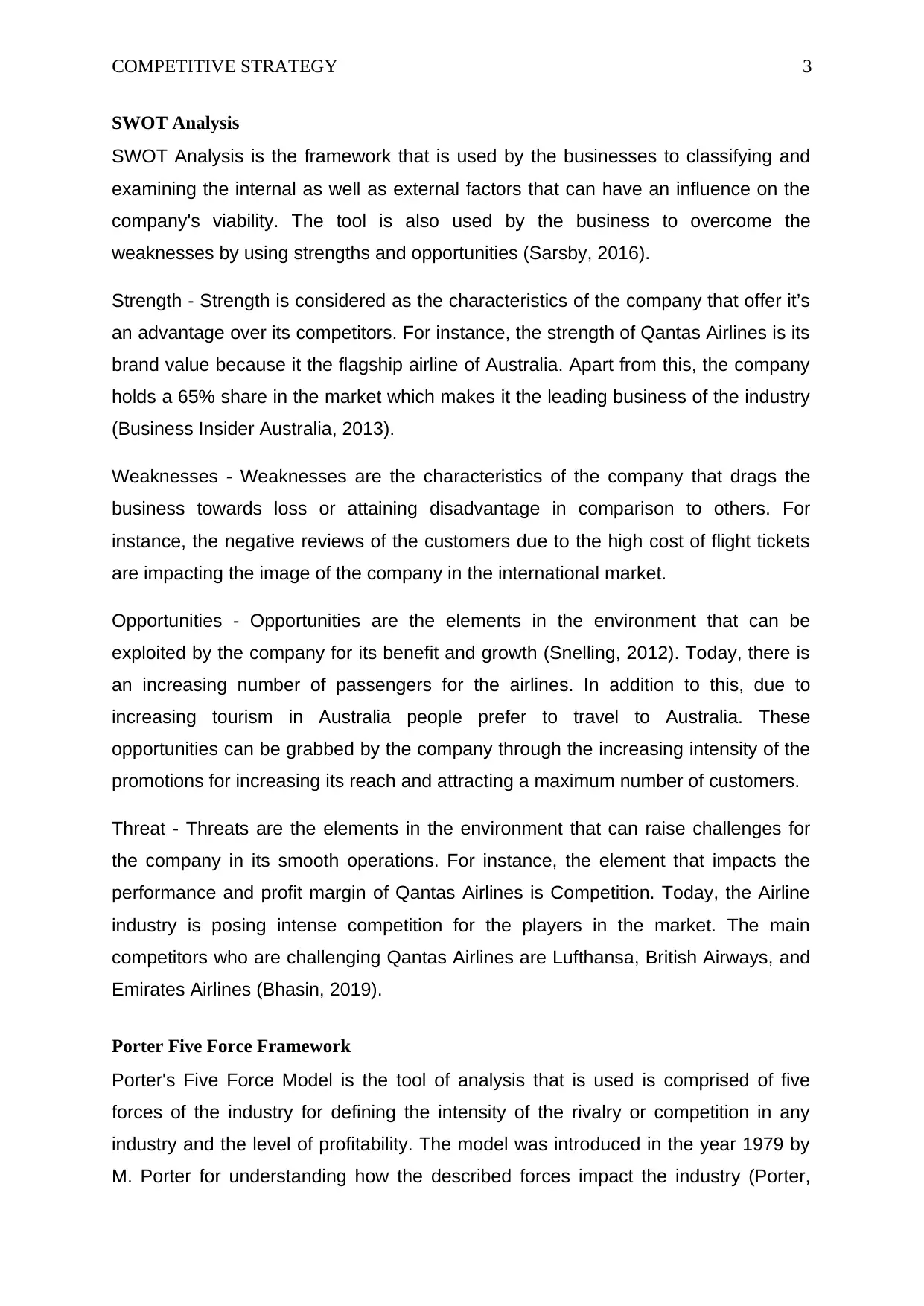
COMPETITIVE STRATEGY 3
SWOT Analysis
SWOT Analysis is the framework that is used by the businesses to classifying and
examining the internal as well as external factors that can have an influence on the
company's viability. The tool is also used by the business to overcome the
weaknesses by using strengths and opportunities (Sarsby, 2016).
Strength - Strength is considered as the characteristics of the company that offer it’s
an advantage over its competitors. For instance, the strength of Qantas Airlines is its
brand value because it the flagship airline of Australia. Apart from this, the company
holds a 65% share in the market which makes it the leading business of the industry
(Business Insider Australia, 2013).
Weaknesses - Weaknesses are the characteristics of the company that drags the
business towards loss or attaining disadvantage in comparison to others. For
instance, the negative reviews of the customers due to the high cost of flight tickets
are impacting the image of the company in the international market.
Opportunities - Opportunities are the elements in the environment that can be
exploited by the company for its benefit and growth (Snelling, 2012). Today, there is
an increasing number of passengers for the airlines. In addition to this, due to
increasing tourism in Australia people prefer to travel to Australia. These
opportunities can be grabbed by the company through the increasing intensity of the
promotions for increasing its reach and attracting a maximum number of customers.
Threat - Threats are the elements in the environment that can raise challenges for
the company in its smooth operations. For instance, the element that impacts the
performance and profit margin of Qantas Airlines is Competition. Today, the Airline
industry is posing intense competition for the players in the market. The main
competitors who are challenging Qantas Airlines are Lufthansa, British Airways, and
Emirates Airlines (Bhasin, 2019).
Porter Five Force Framework
Porter's Five Force Model is the tool of analysis that is used is comprised of five
forces of the industry for defining the intensity of the rivalry or competition in any
industry and the level of profitability. The model was introduced in the year 1979 by
M. Porter for understanding how the described forces impact the industry (Porter,
SWOT Analysis
SWOT Analysis is the framework that is used by the businesses to classifying and
examining the internal as well as external factors that can have an influence on the
company's viability. The tool is also used by the business to overcome the
weaknesses by using strengths and opportunities (Sarsby, 2016).
Strength - Strength is considered as the characteristics of the company that offer it’s
an advantage over its competitors. For instance, the strength of Qantas Airlines is its
brand value because it the flagship airline of Australia. Apart from this, the company
holds a 65% share in the market which makes it the leading business of the industry
(Business Insider Australia, 2013).
Weaknesses - Weaknesses are the characteristics of the company that drags the
business towards loss or attaining disadvantage in comparison to others. For
instance, the negative reviews of the customers due to the high cost of flight tickets
are impacting the image of the company in the international market.
Opportunities - Opportunities are the elements in the environment that can be
exploited by the company for its benefit and growth (Snelling, 2012). Today, there is
an increasing number of passengers for the airlines. In addition to this, due to
increasing tourism in Australia people prefer to travel to Australia. These
opportunities can be grabbed by the company through the increasing intensity of the
promotions for increasing its reach and attracting a maximum number of customers.
Threat - Threats are the elements in the environment that can raise challenges for
the company in its smooth operations. For instance, the element that impacts the
performance and profit margin of Qantas Airlines is Competition. Today, the Airline
industry is posing intense competition for the players in the market. The main
competitors who are challenging Qantas Airlines are Lufthansa, British Airways, and
Emirates Airlines (Bhasin, 2019).
Porter Five Force Framework
Porter's Five Force Model is the tool of analysis that is used is comprised of five
forces of the industry for defining the intensity of the rivalry or competition in any
industry and the level of profitability. The model was introduced in the year 1979 by
M. Porter for understanding how the described forces impact the industry (Porter,
Paraphrase This Document
Need a fresh take? Get an instant paraphrase of this document with our AI Paraphraser
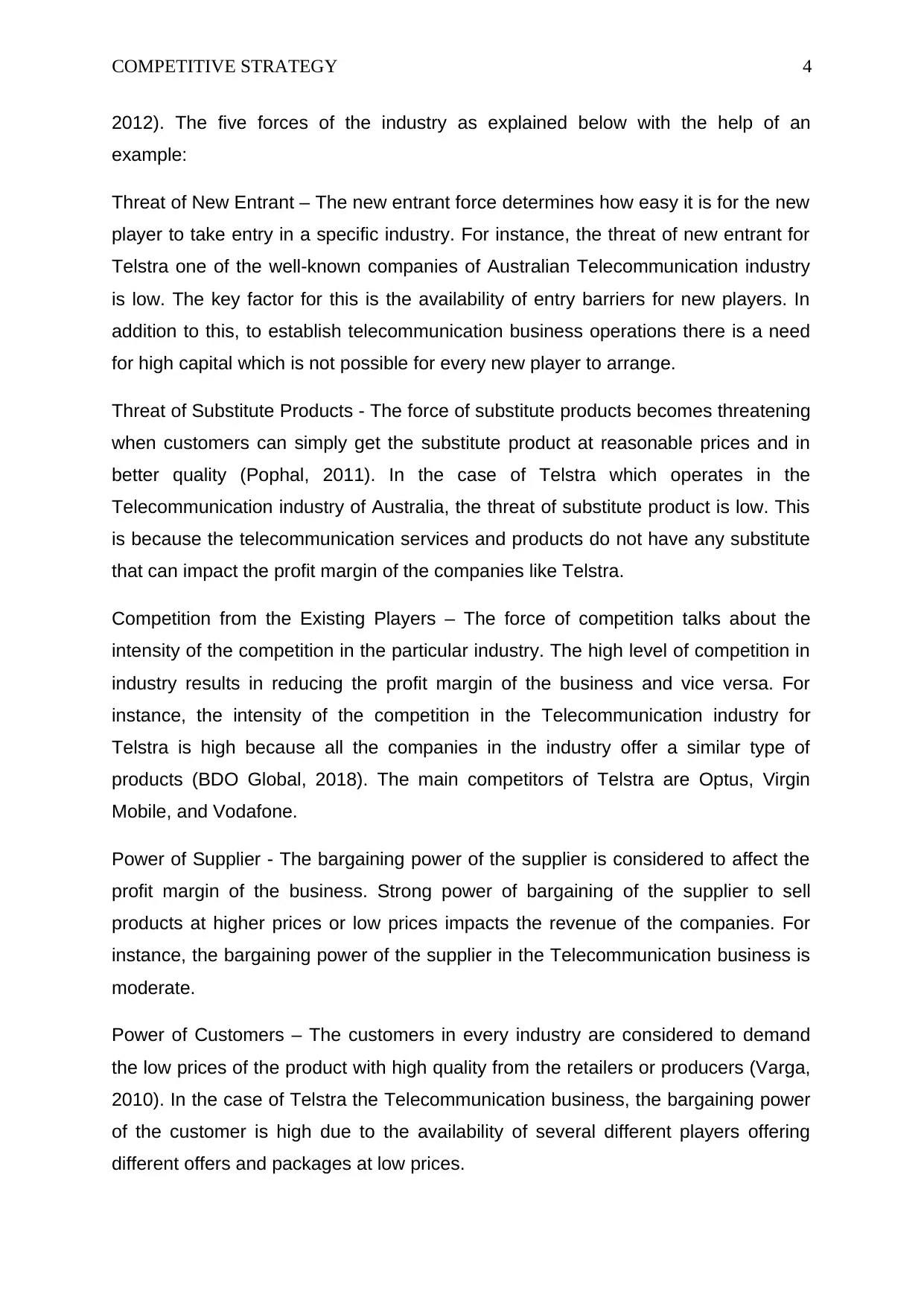
COMPETITIVE STRATEGY 4
2012). The five forces of the industry as explained below with the help of an
example:
Threat of New Entrant – The new entrant force determines how easy it is for the new
player to take entry in a specific industry. For instance, the threat of new entrant for
Telstra one of the well-known companies of Australian Telecommunication industry
is low. The key factor for this is the availability of entry barriers for new players. In
addition to this, to establish telecommunication business operations there is a need
for high capital which is not possible for every new player to arrange.
Threat of Substitute Products - The force of substitute products becomes threatening
when customers can simply get the substitute product at reasonable prices and in
better quality (Pophal, 2011). In the case of Telstra which operates in the
Telecommunication industry of Australia, the threat of substitute product is low. This
is because the telecommunication services and products do not have any substitute
that can impact the profit margin of the companies like Telstra.
Competition from the Existing Players – The force of competition talks about the
intensity of the competition in the particular industry. The high level of competition in
industry results in reducing the profit margin of the business and vice versa. For
instance, the intensity of the competition in the Telecommunication industry for
Telstra is high because all the companies in the industry offer a similar type of
products (BDO Global, 2018). The main competitors of Telstra are Optus, Virgin
Mobile, and Vodafone.
Power of Supplier - The bargaining power of the supplier is considered to affect the
profit margin of the business. Strong power of bargaining of the supplier to sell
products at higher prices or low prices impacts the revenue of the companies. For
instance, the bargaining power of the supplier in the Telecommunication business is
moderate.
Power of Customers – The customers in every industry are considered to demand
the low prices of the product with high quality from the retailers or producers (Varga,
2010). In the case of Telstra the Telecommunication business, the bargaining power
of the customer is high due to the availability of several different players offering
different offers and packages at low prices.
2012). The five forces of the industry as explained below with the help of an
example:
Threat of New Entrant – The new entrant force determines how easy it is for the new
player to take entry in a specific industry. For instance, the threat of new entrant for
Telstra one of the well-known companies of Australian Telecommunication industry
is low. The key factor for this is the availability of entry barriers for new players. In
addition to this, to establish telecommunication business operations there is a need
for high capital which is not possible for every new player to arrange.
Threat of Substitute Products - The force of substitute products becomes threatening
when customers can simply get the substitute product at reasonable prices and in
better quality (Pophal, 2011). In the case of Telstra which operates in the
Telecommunication industry of Australia, the threat of substitute product is low. This
is because the telecommunication services and products do not have any substitute
that can impact the profit margin of the companies like Telstra.
Competition from the Existing Players – The force of competition talks about the
intensity of the competition in the particular industry. The high level of competition in
industry results in reducing the profit margin of the business and vice versa. For
instance, the intensity of the competition in the Telecommunication industry for
Telstra is high because all the companies in the industry offer a similar type of
products (BDO Global, 2018). The main competitors of Telstra are Optus, Virgin
Mobile, and Vodafone.
Power of Supplier - The bargaining power of the supplier is considered to affect the
profit margin of the business. Strong power of bargaining of the supplier to sell
products at higher prices or low prices impacts the revenue of the companies. For
instance, the bargaining power of the supplier in the Telecommunication business is
moderate.
Power of Customers – The customers in every industry are considered to demand
the low prices of the product with high quality from the retailers or producers (Varga,
2010). In the case of Telstra the Telecommunication business, the bargaining power
of the customer is high due to the availability of several different players offering
different offers and packages at low prices.
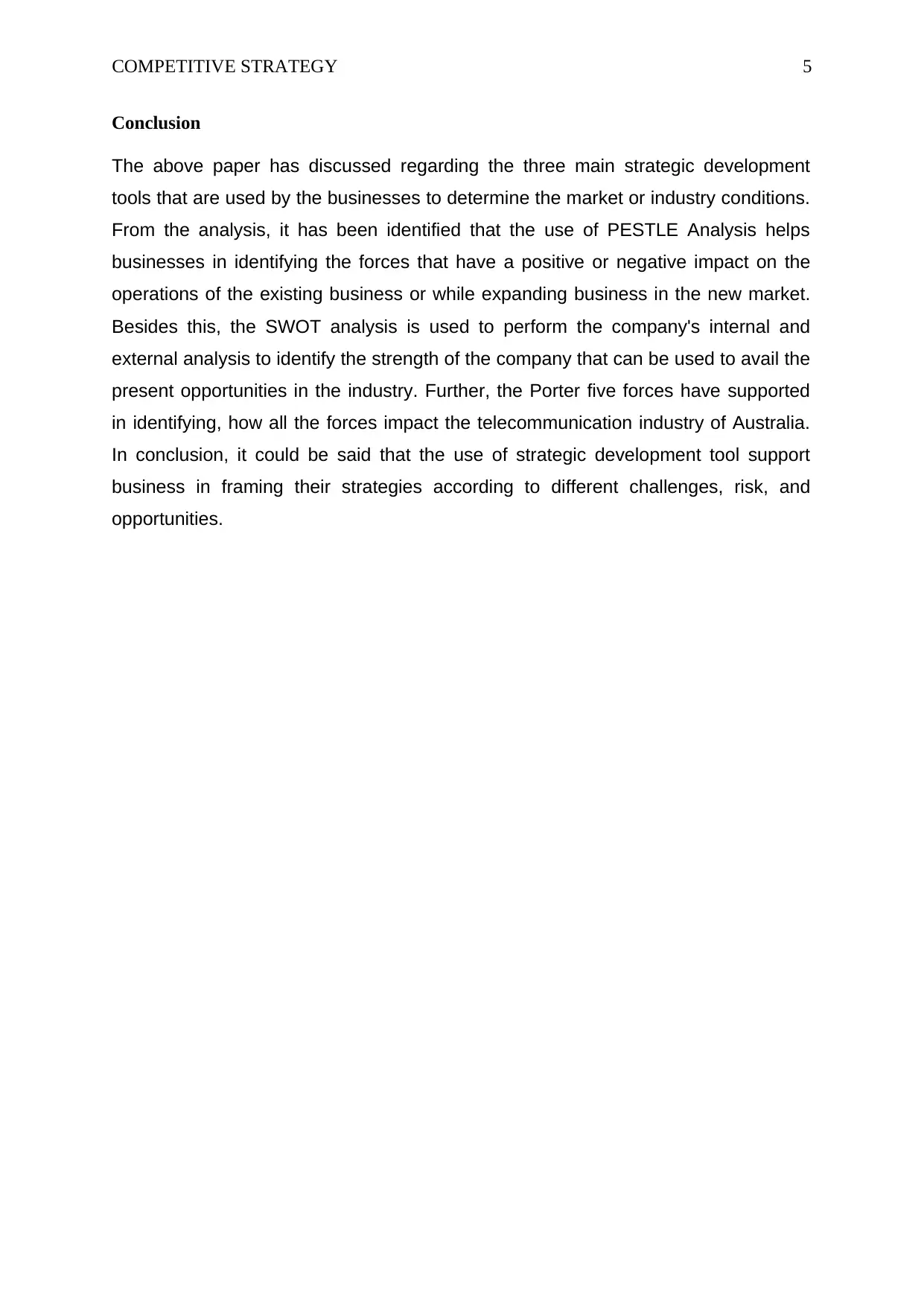
COMPETITIVE STRATEGY 5
Conclusion
The above paper has discussed regarding the three main strategic development
tools that are used by the businesses to determine the market or industry conditions.
From the analysis, it has been identified that the use of PESTLE Analysis helps
businesses in identifying the forces that have a positive or negative impact on the
operations of the existing business or while expanding business in the new market.
Besides this, the SWOT analysis is used to perform the company's internal and
external analysis to identify the strength of the company that can be used to avail the
present opportunities in the industry. Further, the Porter five forces have supported
in identifying, how all the forces impact the telecommunication industry of Australia.
In conclusion, it could be said that the use of strategic development tool support
business in framing their strategies according to different challenges, risk, and
opportunities.
Conclusion
The above paper has discussed regarding the three main strategic development
tools that are used by the businesses to determine the market or industry conditions.
From the analysis, it has been identified that the use of PESTLE Analysis helps
businesses in identifying the forces that have a positive or negative impact on the
operations of the existing business or while expanding business in the new market.
Besides this, the SWOT analysis is used to perform the company's internal and
external analysis to identify the strength of the company that can be used to avail the
present opportunities in the industry. Further, the Porter five forces have supported
in identifying, how all the forces impact the telecommunication industry of Australia.
In conclusion, it could be said that the use of strategic development tool support
business in framing their strategies according to different challenges, risk, and
opportunities.
⊘ This is a preview!⊘
Do you want full access?
Subscribe today to unlock all pages.

Trusted by 1+ million students worldwide
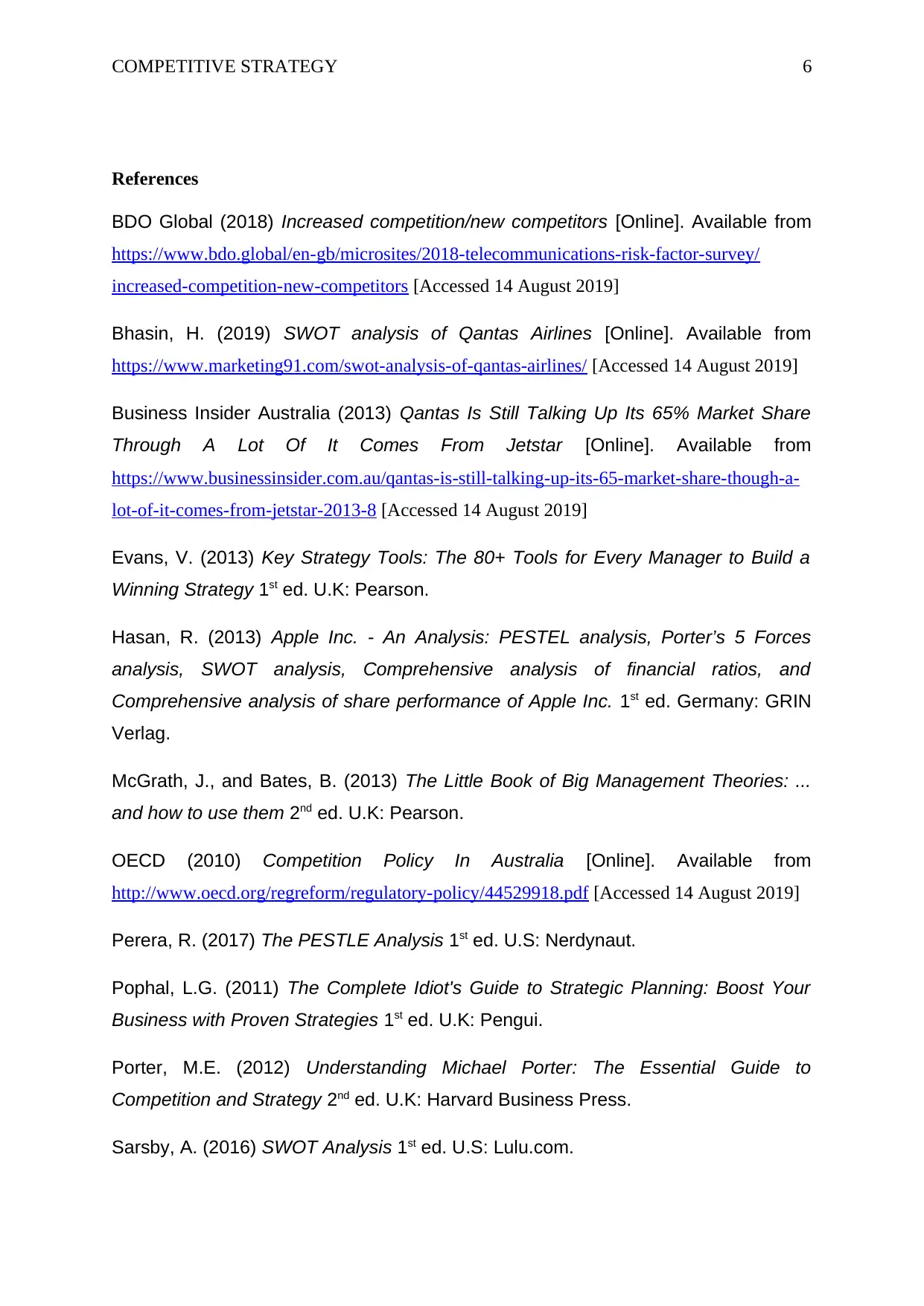
COMPETITIVE STRATEGY 6
References
BDO Global (2018) Increased competition/new competitors [Online]. Available from
https://www.bdo.global/en-gb/microsites/2018-telecommunications-risk-factor-survey/
increased-competition-new-competitors [Accessed 14 August 2019]
Bhasin, H. (2019) SWOT analysis of Qantas Airlines [Online]. Available from
https://www.marketing91.com/swot-analysis-of-qantas-airlines/ [Accessed 14 August 2019]
Business Insider Australia (2013) Qantas Is Still Talking Up Its 65% Market Share
Through A Lot Of It Comes From Jetstar [Online]. Available from
https://www.businessinsider.com.au/qantas-is-still-talking-up-its-65-market-share-though-a-
lot-of-it-comes-from-jetstar-2013-8 [Accessed 14 August 2019]
Evans, V. (2013) Key Strategy Tools: The 80+ Tools for Every Manager to Build a
Winning Strategy 1st ed. U.K: Pearson.
Hasan, R. (2013) Apple Inc. - An Analysis: PESTEL analysis, Porter’s 5 Forces
analysis, SWOT analysis, Comprehensive analysis of financial ratios, and
Comprehensive analysis of share performance of Apple Inc. 1st ed. Germany: GRIN
Verlag.
McGrath, J., and Bates, B. (2013) The Little Book of Big Management Theories: ...
and how to use them 2nd ed. U.K: Pearson.
OECD (2010) Competition Policy In Australia [Online]. Available from
http://www.oecd.org/regreform/regulatory-policy/44529918.pdf [Accessed 14 August 2019]
Perera, R. (2017) The PESTLE Analysis 1st ed. U.S: Nerdynaut.
Pophal, L.G. (2011) The Complete Idiot's Guide to Strategic Planning: Boost Your
Business with Proven Strategies 1st ed. U.K: Pengui.
Porter, M.E. (2012) Understanding Michael Porter: The Essential Guide to
Competition and Strategy 2nd ed. U.K: Harvard Business Press.
Sarsby, A. (2016) SWOT Analysis 1st ed. U.S: Lulu.com.
References
BDO Global (2018) Increased competition/new competitors [Online]. Available from
https://www.bdo.global/en-gb/microsites/2018-telecommunications-risk-factor-survey/
increased-competition-new-competitors [Accessed 14 August 2019]
Bhasin, H. (2019) SWOT analysis of Qantas Airlines [Online]. Available from
https://www.marketing91.com/swot-analysis-of-qantas-airlines/ [Accessed 14 August 2019]
Business Insider Australia (2013) Qantas Is Still Talking Up Its 65% Market Share
Through A Lot Of It Comes From Jetstar [Online]. Available from
https://www.businessinsider.com.au/qantas-is-still-talking-up-its-65-market-share-though-a-
lot-of-it-comes-from-jetstar-2013-8 [Accessed 14 August 2019]
Evans, V. (2013) Key Strategy Tools: The 80+ Tools for Every Manager to Build a
Winning Strategy 1st ed. U.K: Pearson.
Hasan, R. (2013) Apple Inc. - An Analysis: PESTEL analysis, Porter’s 5 Forces
analysis, SWOT analysis, Comprehensive analysis of financial ratios, and
Comprehensive analysis of share performance of Apple Inc. 1st ed. Germany: GRIN
Verlag.
McGrath, J., and Bates, B. (2013) The Little Book of Big Management Theories: ...
and how to use them 2nd ed. U.K: Pearson.
OECD (2010) Competition Policy In Australia [Online]. Available from
http://www.oecd.org/regreform/regulatory-policy/44529918.pdf [Accessed 14 August 2019]
Perera, R. (2017) The PESTLE Analysis 1st ed. U.S: Nerdynaut.
Pophal, L.G. (2011) The Complete Idiot's Guide to Strategic Planning: Boost Your
Business with Proven Strategies 1st ed. U.K: Pengui.
Porter, M.E. (2012) Understanding Michael Porter: The Essential Guide to
Competition and Strategy 2nd ed. U.K: Harvard Business Press.
Sarsby, A. (2016) SWOT Analysis 1st ed. U.S: Lulu.com.
Paraphrase This Document
Need a fresh take? Get an instant paraphrase of this document with our AI Paraphraser
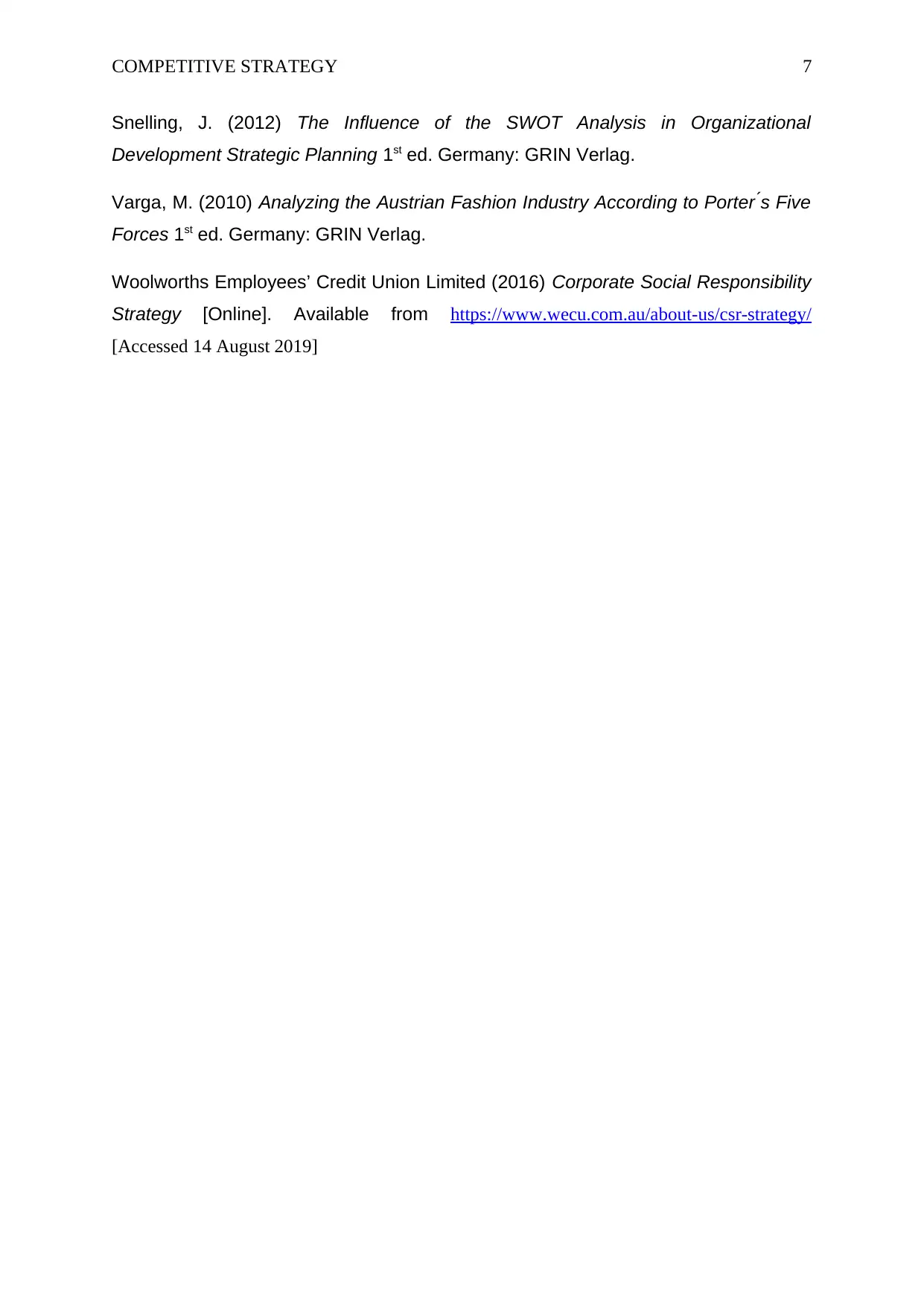
COMPETITIVE STRATEGY 7
Snelling, J. (2012) The Influence of the SWOT Analysis in Organizational
Development Strategic Planning 1st ed. Germany: GRIN Verlag.
Varga, M. (2010) Analyzing the Austrian Fashion Industry According to Porter ́ s Five
Forces 1st ed. Germany: GRIN Verlag.
Woolworths Employees’ Credit Union Limited (2016) Corporate Social Responsibility
Strategy [Online]. Available from https://www.wecu.com.au/about-us/csr-strategy/
[Accessed 14 August 2019]
Snelling, J. (2012) The Influence of the SWOT Analysis in Organizational
Development Strategic Planning 1st ed. Germany: GRIN Verlag.
Varga, M. (2010) Analyzing the Austrian Fashion Industry According to Porter ́ s Five
Forces 1st ed. Germany: GRIN Verlag.
Woolworths Employees’ Credit Union Limited (2016) Corporate Social Responsibility
Strategy [Online]. Available from https://www.wecu.com.au/about-us/csr-strategy/
[Accessed 14 August 2019]
1 out of 8
Related Documents
Your All-in-One AI-Powered Toolkit for Academic Success.
+13062052269
info@desklib.com
Available 24*7 on WhatsApp / Email
![[object Object]](/_next/static/media/star-bottom.7253800d.svg)
Unlock your academic potential
Copyright © 2020–2025 A2Z Services. All Rights Reserved. Developed and managed by ZUCOL.





